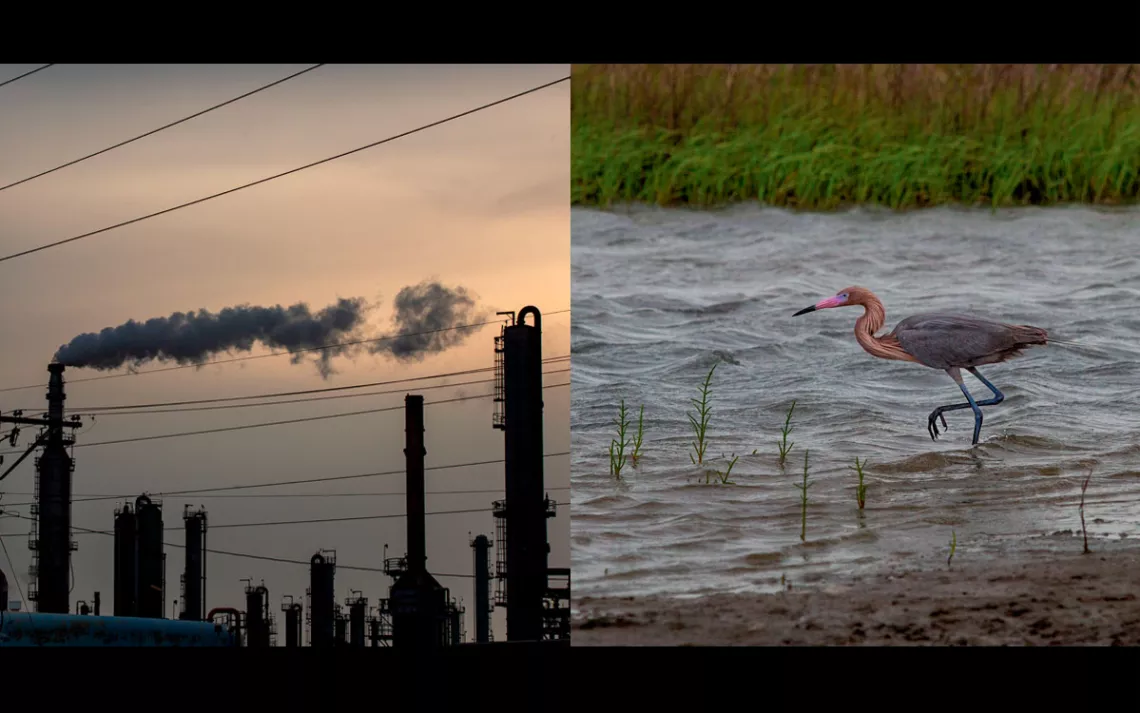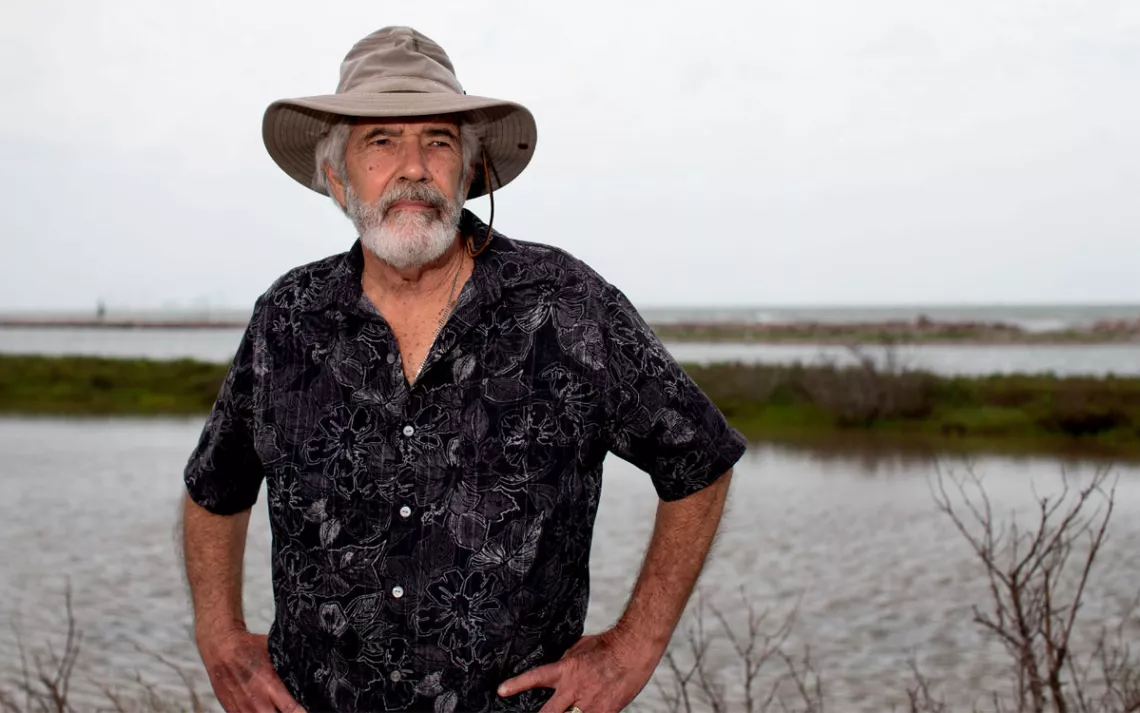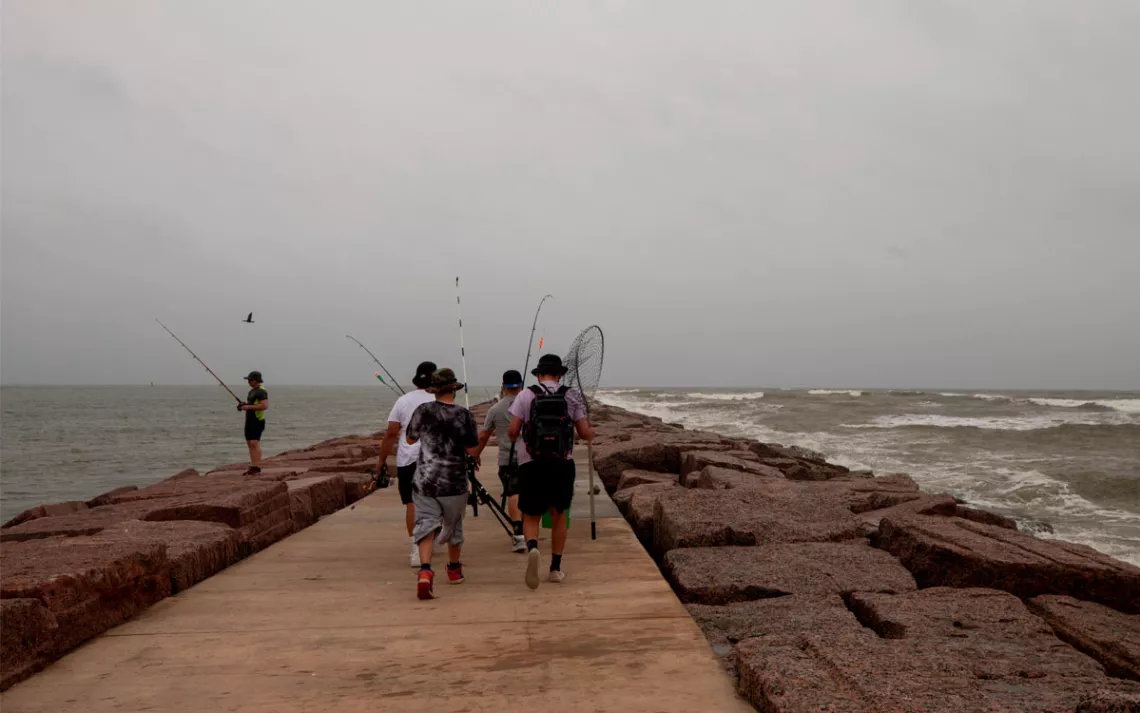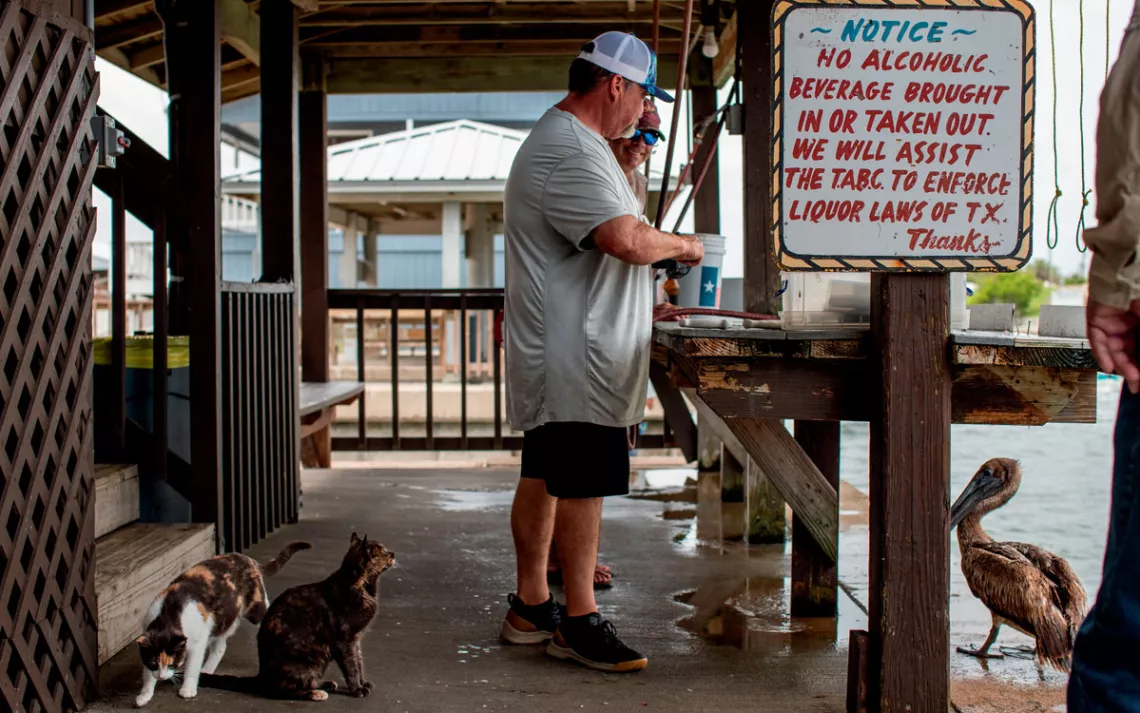In Corpus Christi, Texas, Environmentalists Are Fighting a Slate of Proposed Desalination Plants
The city says it needs extra water. But it's for fossil fuel and plastic corporations—not people

WHEN VISITORS COME to town, Errol Summerlin likes to do what any good Texas host does: He starts up the engine and shows them around. Summerlin lives in Portland, on the outskirts of Corpus Christi, a city of 317,000 people located on Texas's Coastal Bend. The 45-mile tour Summerlin has put together highlights the natural splendor of the region—wide rivers, squelchy bayous, sprawling wetlands, long barrier islands, and the great silver arc of Corpus Christi Bay. This, however, is no leisurely beach jaunt. Summerlin, 71, a former legal aid attorney turned environmental activist, is slender, with a swooping mane of salt-and-pepper hair. He calls his tour Hell's Highway to Paradise. "You're going to see that this place is special," he said with a gravelly drawl as we jumped into his SUV. "And almost every inch of it is under attack."

Errol Summerlin, a former attorney turned environmental activist: "As Corpus Christi goes, so goes the planet."
On the way to the Gulf of Mexico, Summerlin's tour wends through a landscape of staggering industrialization—the jagged stacks of oil refineries and the white cylinders of oil tank farms. A highlight is the world's largest ethane cracking facility. Operated jointly by ExxonMobil and the Saudi Arabian firm SABIC, the plant produces nurdles, the small pellets used in plastics manufacturing. It came online last year, just a few miles from Summerlin's home. The facility features a massive ground flare, roughly 400 feet long by 300 feet wide. When the flaming cauldron roars to life, Summerlin said, the windows in his house rattle and the floors shake.
In response to the industrial transformation that has accelerated in his hometown in recent years, Summerlin in 2018 established the Coastal Alliance to Protect Our Environment (CAPE). Today the group has hundreds of individual supporters along with organizational allies. In a region where industry historically has enjoyed free rein, the upstart organization has mounted several campaigns to slow the growth of the gas and oil facilities that are devouring huge tracts of land in and around Corpus Christi and surrounding communities. "Sometimes dozens of permits are issued in a week," he told me. "Our strategy has been simple: Challenge everything and try to force public hearings." CAPE's tactics, he said, may have played a significant role in the scuttling of a proposed plastics plant—boosters of the plant use the James Bond–esque code name Project Falcon—in 2020. "You never can really know because you can't see behind the scenes, but the timing of their announcement seemed to indicate that we had an impact."

Lamont Taylor is the cofounder of Citizens Alliance for Fairness and Progress, a community group pushing against the proposed Inner Harbor Seawater Desalination Facility.
The industrial onslaught, Summerlin said, began with Congress's lifting of the crude oil export ban in 2015. Since then, Corpus Christi, which sits at the end of a massive pipeline network carrying oil from the Permian Basin, has grown to become the largest crude oil distribution hub in the United States. Each day, dozens of oil tankers pass in and out of Corpus Christi Bay. In 2016, the Port of Corpus Christi exported 30.5 million barrels of oil. Last year, 680 million barrels of crude moved out of the port to points abroad.
What really worries Summerlin these days is water. In June 2022, the city declared a drought and put in place water restrictions. But the drought, Summerlin and others say, is a largely manmade phenomenon that can be traced to 2017. That's when the City of Corpus Christi—which manages the water for users across a roughly 5,400-square-mile area spanning seven counties—gave 20 million gallons of water a day to ExxonMobil and SABIC for their then-proposed Gregory plastics facility. When the companies first approached Corpus Christi leaders, Summerlin explained, the city had no additional water to give. That all changed in 2016 with the completion of the Mary Rhodes II Pipeline, which brought water to Corpus Christi from the nearby Lower Colorado (not to be confused with the much larger Colorado River of the American West). Suddenly, the city had access to an additional 40 million gallons of water per day.
As the human population grows and water supplies become more vulnerable to climate change disruptions, calls for using seawater as a water source are becoming louder.
Rather than using that new supply as a cushion for future population growth or as a hedge against drought, city leaders gave it to industry, with no public hearings or notice. "They opened the spigots of that pipeline in August of 2016, and once it was operating for about five months, they wrote a letter to Exxon saying, 'You can have your 20 million gallons,'" Summerlin said. The following year, the city gave away another 6 million gallons per day to a company called Steel Dynamics. Though figures vary, most estimates suggest that industrial users now command between 60 and 80 percent of Corpus Christi's total water supply.
The staggering growth of the past decade is only the beginning. City and industry leaders are on a quest to transform the Port of Corpus Christi into a petrochemical and refining hub that will rival, and perhaps someday even dwarf, the massive Port of Houston, 200 miles north. Among various projects in the works are a massive hydrogen-production facility that, if constructed, will require tens of millions of gallons of water per day. A document obtained from a 2019 Corpus Christi city council meeting laid out the city's plans to send an additional 55 million gallons per day to industrial facilities by 2030—far more water than the city has in its current portfolio. With local surface water supplies strained to the breaking point, city and industry leaders are on the hunt for new, unconventional sources.

Anglers near Port Aransas fish for sea trout and redfish.
The great arc of Corpus Christi Bay may become such a source. Corporate executives, backed by elected officials, believe that seawater drawn from the 167-square-mile body of water—which in most places is no more than 15 feet deep—can supply the city's growing needs. "Building an uninterruptible water source is extremely important for the future of Corpus Christi," said Mayor Paulette Guajardo in a 2022 press release announcing a permit for a desalination plant in the city's inner harbor. "Our ability to grow, attract new business, and create great jobs is dependent upon our ability to secure our water source."
There are now plans in the works for five marine desalination plants along Corpus Christi Bay, each of which would siphon tens of millions of gallons of water daily from the bay and transform it into freshwater. If built, they would be the first seawater desalination plants in the state of Texas. And that, say critics like Summerlin, is a scenario that must never come to pass.
The five plants—two currently proposed by the City of Corpus Christi, two by the Port of Corpus Christi, and another by a plastics company—would catalyze a new wave of industrial growth that would harm neighborhoods and devastate the ecosystems and fisheries of Corpus Christi Bay and adjacent stretches of the Gulf of Mexico. The projects collectively carry a price tag of $2.6 billion. The long-term social and ecological costs would likely be far higher. (City and port officials did not respond to requests for comment about these projects for this story.)
Summerlin believes that Corpus Christi faces enormous environmental risks, and there is little to no upside for residents in terms of bolstering water supplies. "This water is not for people," he said. "It's for industry."

Corpus Christi Bay remains an ecological treasure, providing sanctuary for fish, mammals, and shorebirds.
But it's more than that. Desalination is the linchpin for all visions of the region's future industrial growth. According to the 2021 Coastal Bend Regional Water Plan, the water needs of the region's manufacturing sector will increase 33-fold over the next 50 years (the municipal net water draw, by comparison, is expected to remain virtually stable). And seawater desalination is forecast to supply nearly two-thirds of that additional water. "Exxon couldn't make its final investment decision to locate here until they were assured that they had the water commitment from the City of Corpus Christi," Summerlin said. "Once they got that, three weeks later, the final investment decision was announced. All these new industries are doing the same. They are waiting to make their final investment decisions based on whether they get the water. They are waiting to see if these desalination plants get built."
THE SITUATION FACING Corpus Christi is extreme, but it's also emblematic of a growing interest in desalination across the globe. Since 2000, desalination capacity worldwide has more than quadrupled. As the human population grows and water supplies become more vulnerable to climate change disruptions, calls for using seawater as a water source are becoming louder. Last year in California, two seawater desalination plants—one in Monterey and the other in Dana Point—were approved within a month of each other. If built, the two plants will be the first desalination facilities constructed in California in nearly a decade and will collectively produce roughly 10 million gallons of freshwater a day. Arizona has invested $1 billion exploring new water-supply strategies, including a massive desalination scheme that would treat water from the Sea of Cortez and deliver it to the Phoenix metro area via a 200-mile pipeline.
No region has adopted desalination technology as thoroughly as the oil-rich nations of the Arabian Gulf—Saudi Arabia, the United Arab Emirates, Oman, Bahrain, and Kuwait. Collectively, they have the capacity to siphon 5.9 billion gallons per day from the Arabian Gulf, a volume representing almost half of all seawater desalination capacity worldwide. This is a glimpse of the future, according to a report from the International Energy Agency. In 2016, desalination in the Middle East accounted for 3 percent of its water supply; today that total is well over 50 percent. Some parts of the region are nearly completely reliant on the technology. The city of Dubai, for example, generates more than 98 percent of its water supply by way of desalination. The Middle East's dependence on seawater will only continue to grow. By 2040, according to the IEA, its desalination capacity is projected to increase by about 12-fold.
The first large-scale, evaporator-based desalination plant was built in 1951, in Kuwait. Since then, desalination plants have become more energy efficient, incorporating semipermeable membranes rather than using flash distillation (a process that puts seawater under tremendous heat and pressure, transforming it from liquid to vapor to separate it from the salt). Despite the advances, modern reverse-osmosis desalination plants still require huge amounts of energy. To treat 660,000 gallons of seawater (the volume contained in an Olympic-size swimming pool), the average reverse-osmosis desalination plant uses the same amount of energy it takes to power roughly 350 US homes for a day. And most of that energy comes from fossil fuels. In the Middle East, according to the IEA, more than 99 percent of the energy for desalination is supplied by oil and methane gas.
In addition to emitting a prodigious amount of carbon pollution, the desalination process generates vast amounts of brine, which can be twice as salty as seawater. Desalination brine has been found to contain elevated levels of heavy metals. In most cases, this waste is disposed of by simply pumping it back into the ocean—a practice that can have drastic consequences for marine ecosystems. In the Arabian Gulf, brine discharge has likely contributed to the formation of massive dead zones. This effluent is not only extremely salty but also significantly hotter than the water taken in, magnifying the effect of climate-driven ocean warming. One study estimated that 70 percent of the Arabian Gulf's coral reefs have been lost during the past 30 years because of a combination of urbanization, rising ocean temperatures, and increased salinity and heat from desalination brine.
Beyond the ecological damage, desalination's infrastructure poses serious threats to human communities, especially poor communities of color. One of the five plants in Corpus Christi is planned less than 10 minutes from the glass-and-steel high-rises of downtown, in an embattled neighborhood called Hillcrest. Among Corpus Christi's last historically Black enclaves, Hillcrest lies at the margin of what's known locally as Refinery Row, a roughly 10-mile unbroken stretch of petrochemical plants and other industrial facilities.
On a sunny morning, at a church in the center of Hillcrest, I met with Lamont Taylor, a longtime resident and the cofounder of Citizens Alliance for Fairness and Progress, a community group pushing against the construction of the $236 million Inner Harbor Seawater Desalination Facility. The plant would occupy 33 acres—roughly the size of 25 football fields. It would also burn huge volumes of methane gas and slurp up about 83 million gallons of seawater daily while discharging 45 million gallons of brine back into the bay.
I arrived a few minutes early and waited in my rental car in the church parking lot, watching a front-end loader smash a wooden bungalow to pieces. Within minutes, the small house—probably a century or more old—had been reduced to a heap of jagged timber. When Taylor arrived, I told him about what I had seen. He said it's the sort of sight you get used to in Hillcrest. Over the past eight years, more than 300 homes have been razed, part of a systematic home-removal program being undertaken by the Texas Department of Transportation to make way for the Corpus Christi Harbor Bridge, whose towering concrete stanchions loomed in the distance. The new bridge will replace the Harbor Bridge and allow supertankers that currently can't get under the span to navigate into the harbor.
We drove along the northern side of the neighborhood, past Refinery Row's Gothic skyline of pipes and smokestacks. "Flint Hills, Citgo, Valero," Taylor said, rattling off the names of companies that have besieged Hillcrest. "They are all right here. They have been encroaching on this neighborhood forever."
Taylor, 70, was raised in Hillcrest. A large, gregarious man, he attended Trinity University in San Antonio, where he studied urban planning and design. For the first part of its history, he said, Hillcrest was a predominantly white part of town. As the first refineries and other factories were built in the 1940s and '50s, white residents began to move out. Black residents, redlined into the rapidly industrializing zone, filled the void. But even as industrialization began to transform the neighborhood in the latter half of the 20th century, Hillcrest remained a vibrant working-class community filled with music clubs and family-owned businesses. "There were fruit trees everywhere," Taylor said. "Everyone had gardens."
Today, the businesses are gone. The fruit trees and gardens have vanished. Taylor's body, like the community, bears the scars of decades of industrial blight. He is a survivor of stage 4 bladder cancer. "It didn't metastasize," he said. "That's the only reason I'm still here." Many of his friends who grew up in Hillcrest have also been diagnosed with rare cancers along with other ailments such as asthma and heart disease.
After a few minutes, Taylor and I came to a large, empty parcel where dozens of houses once stood—the proposed location of the Inner Harbor desalination facility. Last year, Taylor and several other local activists filed a Title VI civil rights complaint against the city to halt construction, alleging that the plant "would exacerbate the existing disproportionate health and safety harms from decades of industrialization, isolation, and pollution." Taylor told me, "If they build this plant, it's the death knell for this neighborhood." He added that the plant would not only add to the crush of factories; the new water made available would intensify the industrial activity around the neighborhood. "They don't care who gets in their way. It's slash and burn."
Even as Hillcrest is being erased from the map, its character is changing. Latinos now account for roughly 58 percent of the remaining residents, and across Corpus Christi, Latino neighborhoods lie at the front lines of the region's industrial expansion. "There's not a day that goes by on my social media where I don't see some medical benefit for someone with cancer," said Elida Castillo, program director for Chispa Texas, the Latino wing of the League of Conservation Voters. "People are asking what is going on, but they are not connecting it to industry because [industry] is not disclosing what we are breathing in."
In addition to the physical harm they cause, desalination plants impose a heavy financial burden on poor communities. "Everywhere I have seen seawater desal adopted, there has been a sharp spike in water rates for users," Jim Klein, a Corpus Christi city council member and chair of the Sierra Club's Coastal Bend Group, told me. He noted that ever since the Carlsbad desalination plant in Southern California went online in 2015, water rates there have risen significantly. "I don't want that for Corpus Christi because a lot of our residents are living at, or close to, the poverty line and can't afford it."
Taylor and I soon arrived at the intersection of Lobo and Sam Rankin Streets, a place once bustling with Black-owned businesses that is now cut off from the rest of the neighborhood by a tangle of highways and dead-end roads. The Saint Paul United Methodist Church and the Unity Chapel Funeral Home stood beside a scattering of ramshackle homes and yawning vacant lots. "This is the long business," Taylor said with a laugh. "But hey, at least they left us the funeral parlor and the church to carry us out in."
AN HOUR AWAY from Hillcrest, in the town of Port Aransas, the grimness of Refinery Row seemed far away. Seafood shacks and surf shops lined the main street, and the air was freshened by a constant ocean breeze. In shallow inlets around town, roseate spoonbills and reddish egrets stalked their prey.
Waiting for me was Kristin Nielsen, an aquatic toxicologist and assistant professor at the University of Texas's Marine Science Institute. Nielsen's work focuses on the effects of pollution and climate change on the ecosystems of Corpus Christi Bay. We walked a short distance from the brick edifice of the institute to the edge of a wide, straight waterway called the Corpus Christi Ship Channel. Along the shore, fishermen cast into the current, hoping to snag a sea trout or a redfish, two of the most sought-after sport species in these waters. Suddenly, two dolphins arced up and then disappeared under the surface. A few miles out in the gulf, three oil tankers sat in formation, awaiting passage into the bay.
Despite the metastasizing industry along its shores, Corpus Christi Bay remains an ecological treasure, providing sanctuary for fish, mammals, and shorebirds, including threatened and endangered species. On its eastern flank, the bay is protected by a long chain of barrier islands, which effectively block water exchange with the Gulf of Mexico. Because of this, Corpus Christi Bay experiences little tidal action. Eggs and free-floating larvae of fish and other organisms are moved along by wind-driven currents, which transport them to shallow estuaries, where they can mature in the protection of dense beds of seagrass.
In addition to providing important habitat, the bay is also a superhighway of industry, where dozens of oil tankers course each day in and out. Nielsen pointed across the channel to Harbor Island, where the Port of Corpus Christi (which has emerged as a player and a rival to the City of Corpus Christi in the push for desalination) has proposed an $802 million desalination plant that would draw in 150 million gallons of seawater per day. The waste, some 95 million gallons of it, would be piped into the shipping channel. There, according to engineers, the waste would disperse by way of natural currents and specially designed "diffusers."
Nielsen said this is not a good idea. The shipping channel happens to be one of the few places along the coast where the waters of the bay and gulf mix—and the dynamics of that interaction are not well understood. Any industrial project that might alter the salinity of the bay's ecosystems should be approached with extreme caution, she said. "In this area, there is an eddy that swirls around, but that is not very well characterized," she said. "We just really don't have any good models to show us what is going on."
A few years ago, Nielsen was approached by the University of Texas's Marine Science Advisory Council to author a report quantifying the potential toxic effects of desalination brine on early-life-stage fish. Her findings highlighted the risks of discharging tens of millions of gallons of desalination effluent into the shallow waters of Corpus Christi Bay. "A lot of these species depend on specific salinity gradients for their various life stages," she said. "And when you start altering those salinity gradients [by discharging brine], you can remove those organisms' capacity to develop and survive."
The ecological and economic costs of disrupting the web of life in Corpus Christi Bay cannot be overstated, she said. "This is a really ecologically sensitive and valuable area that is home to a lot of endangered species. You have fish populations that support billions of dollars in revenue for the state of Texas. Redfish and sea trout alone account for two-thirds of that value. From a socioeconomic standpoint, you can imagine what would happen to local land values if the fishing were gone."
Nielsen believes that the risk could be greatly reduced by putting the discharge farther offshore. There, she said, the brine could be more effectively dispersed in the deeper water and stronger currents of the gulf. To date, however, representatives from the city and port have balked at proposals to move the outflows into open ocean, citing engineering complexity and dramatic increases in cost. The Environmental Protection Agency may force the port's hand. A letter written last September by EPA regional administrator Earthea Nance stated that the agency could reject the state permit on the grounds that the port's proposal to discharge brine directly into Corpus Christi Bay may violate the Clean Water Act.
Others say that desalination will never work in Corpus Christi Bay. "It's a mirage. It's an illusion," said Encarnación "Chon" Serna, a semi-retired engineer, at his home at the edge of the bay in Portland. During a career that spanned over 40 years, he told me, he worked for several chemical and oil and gas companies, including Exxon, in a variety of roles—from overseeing the operations of chemical plants to designing and conducting feasibility studies for new facilities. His backyard swept gently toward the water's edge to an elevated walkway built over a swath of salt marsh. Beyond, a fleet of pelicans glided over the gray waters like marionettes suspended by invisible strings.
Before the industrial rush of recent years, the view from Serna's home took in the low dunes and gentle curve of the bay. Now that same stretch is filled with the spars and smokestacks of dozens of chemical plants. When Serna first moved here more than 30 years ago, flounder, redfish, and sea trout proliferated in the shallow waters of the bay. "My son Miguel caught a 28-inch flounder right there, just off the pier," he said. Now the fish are exceedingly rare. The seagrass once covered the shallows where massive tankers now cruise and industrial plants discharge effluent. If the Port of Corpus Christi's proposed $457 million La Quinta desalination plant is built, a half mile to the east of his home, Serna worries that the marine bounty might disappear altogether. "All that will be left is the hardhead catfish," he said. "They can pretty much live on the land."
During his six-year tenure at Exxon in the 1980s, Serna was invited to participate in a symposium on reverse-osmosis desalination of seawater. He said he and company executives saw firsthand the technical impracticability of desalination in the shallow, biologically rich waters of the bay. "They saw the monster behind desalination by reverse osmosis, with open intakes and discharges into a closed system," he said. Instead of pursuing a technology that they knew couldn't be deployed effectively at that time, Serna said, Exxon did what any multinational oil company with limitless financial resources would do. It grabbed the "low-hanging fruit." "They went and got all the water rights they could from Lake Texana and Lake Mathis, the reservoirs and the rivers," he said.
The current push for desalination, Serna maintains, flies in the face of those past lessons, not to mention basic science. With data in hand, Serna has become critical of the push for mass-scale desalination. He has even been removed from community meetings because of his sometimes confrontational manner. "I don't have a PhD," Serna said, his voice swelling with righteous anger. "I'm an engineer. And there is one thing that I know how to do. I can look at drawings and mass balances and uncover shenanigans better than anyone."
From a folder, he produced a set of flowcharts and explained why reverse osmosis is doomed to fail in Corpus Christi Bay. The problem, he said, is twofold. The first issue is the hydrodynamics of Corpus Christi Bay. "There is no strong current," he said. Without that flushing tidal action, the water becomes increasingly saline as multiple plants siphon millions of gallons of seawater and spit millions of gallons of brine back into the bay. "Just imagine it: one plant sucking 90 million gallons per day, the other two sucking 150 million gallons per day," he said. "And then you are going to return that high-salinity water right to where you are pumping water in. It's just not going to work."
The second factor is the composition of the water itself. "Reverse osmosis only removes what is in the solution, the salts," he told me. "Everything else in suspension has to be removed beforehand or it will foul the filters." The water of the bay is loaded with organic materials—plankton and algae, not to mention fish eggs and larva. These so-called biosolids must be eliminated in a separate process and disposed of in landfills. This pretreatment phase is being vastly downplayed by desalination's boosters, Serna said, and will generate prodigious volumes of solid waste, followed by a constant stream of trucks hauling the waste away.
Serna said it is irresponsible for the City and Port of Corpus Christi to push these massively expensive facilities without first explaining to the public—who will be on the hook to pay for them by way of taxes and higher water bills—what the costs will be. "At least conduct a pilot test," he said. "Build a small plant first, and prove that it can work. But they don't want to do that because they know it doesn't work."
Serna took a deep breath and offered his conclusion: "This is not just a boondoggle; it's a conspiracy."
THE SUN WAS descending, and Errol Summerlin and I had a few more stops on the Hell's Highway tour. He parked along a golf course, beside a group of large houses on the eastern fringe of Portland. Compared with the hardscrabble homes in Hillcrest, the edifices here, beside the NorthShore Country Club, were palatial (one might less charitably call them McMansions) and occupied by a far wealthier, whiter demographic. "People who live here work in these [petrochemical] industries," he said.
We walked down the street, climbing onto the knoll of the golf course. Over a rise, the massive smokestack of an iron plant operated by the Austrian firm Voestalpine came into view. We were little more than a mile from Chon Serna's house, and from this nearer vantage, the full scale of the industrial buildout along the bay's northeastern shore could be appreciated. "None of this was here 10 years ago," Summerlin said, sweeping a hand across the horizon. A skyline of ragged steel ran as far as the eye could see and seemed to melt into the reddening waters of the bay. Behind us, the refinery towers pricked at the sky like the quills of a metallic porcupine. Summerlin traced a finger along the shoreline, pointing to the intake for the proposed La Quinta plant. "If desalination happens, this is only the beginning."
I asked Summerlin if he thought he and his small band of local activists had any chance of stopping this corporate juggernaut. To me it seemed as if we were peering into the glowing core of the reactor of industrial capitalism itself. "We've slowed things down," he said. "And if you would have asked me if we could have done that when we started out five years ago, I would have probably said no."
Summerlin recalled a BBC film crew that visited Corpus Christi a few years ago to work on a video report about the rapid expansion of the city's crude oil and methane gas exports. He said he told the reporter, "As Corpus Christi goes, so goes the planet."
"That seems right to me," Summerlin added. "We are trying to protect our way of life, our city, and our environment. But what is going on here is happening on such a massive scale that it has consequences for the entire planet. I'd say that we have no choice but to fight."
Two wealthy California towns are looking to desalination to bolster flagging water supplies. But that water would come at a steep cost to the environment and local communities: sc.org/ca-desal.
 The Magazine of The Sierra Club
The Magazine of The Sierra Club



